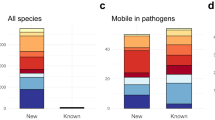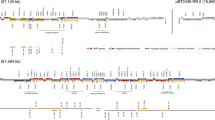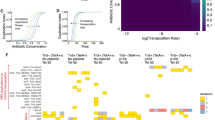Abstract
Glycopeptide antibiotics are produced by Actinobacteria through biosynthetic gene clusters that include genes supporting their regulation, synthesis, export and resistance. The chemical and biosynthetic diversities of glycopeptides are the product of an intricate evolutionary history. Extracting this history from genome sequences is difficult as conservation of the individual components of these gene clusters is variable and each component can have a different trajectory. We show that glycopeptide biosynthesis and resistance in Actinobacteria maps to approximately 150–400 million years ago. Phylogenetic reconciliation reveals that the precursors of glycopeptide biosynthesis are far older than other components, implying that these clusters arose from a pre-existing pool of genes. We find that resistance appeared contemporaneously with biosynthetic genes, raising the possibility that the mechanism of action of glycopeptides was a driver of diversification in these gene clusters. Our results put antibiotic biosynthesis and resistance into an evolutionary context and can guide the future discovery of compounds possessing new mechanisms of action, which are especially needed as the usefulness of the antibiotics available at present is imperilled by human activity.
This is a preview of subscription content, access via your institution
Access options
Access Nature and 54 other Nature Portfolio journals
Get Nature+, our best-value online-access subscription
$29.99 / 30 days
cancel any time
Subscribe to this journal
Receive 12 digital issues and online access to articles
$119.00 per year
only $9.92 per issue
Buy this article
- Purchase on Springer Link
- Instant access to full article PDF
Prices may be subject to local taxes which are calculated during checkout






Similar content being viewed by others
Data availability
All genome sequences produced for this study (22 organisms) have been deposited to GenBank under the BioProject accession number PRJNA472056. The source of every BGC is listed in Supplementary Table 1. The dates for all nodes in all of the dated trees are provided in Supplementary Table 2. The input BGC sequences, 16S rRNA sequences, 16S rRNA alignment, 16S rRNA tree, concatenated TIGRFAM core genome sequence alignment, all dated BEAST species trees, extracted gene/domain family sequences, annotated gene/domain families, gene/domain family alignments, gene/domain family trees and all reconciliations (scheme A00, A10, B00, B10, C01 and C03) are available at http://github.com/waglecn/GPA_evolution.
Code availability
Reconciliations were visualized by overlaying the reconciled nodes of each gene tree to the species tree using a custom Python script, which is available at http://github.com/waglecn/GPA_evolution.
References
Thaker, M. N. et al. Identifying producers of antibacterial compounds by screening for antibiotic resistance. Nat. Biotechnol. 31, 922–927 (2013).
Weber, T. et al. antiSMASH 3.0—a comprehensive resource for the genome mining of biosynthetic gene clusters. Nucleic Acids Res. 43, W237–W243 (2015).
Skinnider, M. A., Merwin, N. J., Johnston, C. W. & Magarvey, N. A. PRISM 3: expanded prediction of natural product chemical structures from microbial genomes. Nucleic Acids Res. 45, W49–W54 (2017).
Cruz-Morales, P. et al. Phylogenomic analysis of natural products biosynthetic gene clusters allows discovery of arseno-organic metabolites in model streptomycetes. Genome Biol. Evol. 8, 1906–1916 (2016).
Marshall, C. G., Broadhead, G., Leskiw, B. K. & Wright, G. D. d-Ala-d-Ala ligases from glycopeptide antibiotic-producing organisms are highly homologous to the enterococcal vancomycin-resistance ligases VanA and VanB. Proc. Natl Acad. Sci. USA 94, 6480–6483 (1997).
Nicolaou, K. C., Boddy, C. N., Brase, S. & Winssinger, N. Chemistry, biology, and medicine of the glycopeptide antibiotics. Angew. Chem. Int. Ed. 38, 2096–2152 (1999).
Chen, H., Tseng, C. C., Hubbard, B. K. & Walsh, C. T. Glycopeptide antibiotic biosynthesis: enzymatic assembly of the dedicated amino acid monomer (S)-3,5-dihydroxyphenylglycine. Proc. Natl Acad. Sci. USA 98, 14901–14906 (2001).
Yim, G., Thaker, M. N., Koteva, K. & Wright, G. Glycopeptide antibiotic biosynthesis. J. Antibiot. 67, 31–41 (2014).
Lo Grasso, L. et al. Two master switch regulators trigger A40926 biosynthesis in Nonomuraea sp. strain ATCC 39727. J. Bacteriol. 197, 2536–2544 (2015).
Kilian, R., Frasch, H. J., Kulik, A., Wohlleben, W. & Stegmann, E. The VanRS homologous two-component system VnlRSAb of the glycopeptide producer Amycolatopsis balhimycina activates transcription of the vanHAX Sc genes in Streptomyces coelicolor, but not in A. balhimycina. Micro. Drug Resist. 22, 499–509 (2016).
Chevrette, M. G. & Currie, C. R. Emerging evolutionary paradigms in antibiotic discovery. J. Ind. Microbiol. Biotechnol. 46, 257–271 (2018).
Selengut, J. D. et al. TIGRFAMs and Genome Properties: tools for the assignment of molecular function and biological process in prokaryotic genomes. Nucleic Acids Res. 35, D260–D264 (2007).
Price, M. N., Dehal, P. S. & Arkin, A. P. FastTree 2–approximately maximum-likelihood trees for large alignments. PLoS ONE 5, e9490 (2010).
Drummond, A. J. & Rambaut, A. BEAST: Bayesian evolutionary analysis by sampling trees. BMC Evol. Biol. 7, 214 (2007).
Huerta-Cepas, J., Serra, F. & Bork, P. ETE 3: reconstruction, analysis, and visualization of phylogenomic data. Mol. Biol. Evol. 33, 1635–1638 (2016).
Jombart, T., Kendall, M., Almagro-Garcia, J. & Colijn, C. treespace: statistical exploration of landscapes of phylogenetic trees. Mol. Ecol. Resour. 17, 1385–1392 (2017).
Battistuzzi, F. U., Feijao, A. & Hedges, S. B. A genomic timescale of prokaryote evolution: insights into the origin of methanogenesis, phototrophy, and the colonization of land. BMC Evol. Biol. 4, 44 (2004).
McDonald, B. R. & Currie, C. R. Lateral gene transfer dynamics in the ancient bacterial genus Streptomyces. mBio 8, 00644-17 (2017).
Cimermancic, P. et al. Insights into secondary metabolism from a global analysis of prokaryotic biosynthetic gene clusters. Cell 158, 412–421 (2014).
Goodman, M., Czelusniak, J., Moore, G. W., Romero-Herrera, A. E. & Matsuda, G. Fitting the gene lineage into its species lineage, a parsimony strategy illustrated by cladograms constructed from globin sequences. Syst. Biol. 28, 132–163 (1979).
Stolzer, M., Siewert, K., Lai, H., Xu, M. & Durand, D. Event inference in multidomain families with phylogenetic reconciliation. BMC Bioinform. 16, S8 (2015).
Libeskind-Hadas, R., Wu, Y. C., Bansal, M. S. & Kellis, M. Pareto-optimal phylogenetic tree reconciliation. Bioinformatics 30, i87–i95 (2014).
Jacox, E., Chauve, C., Szollosi, G. J., Ponty, Y. & Scornavacca, C. ecceTERA: comprehensive gene tree-species tree reconciliation using parsimony. Bioinformatics 32, 2056–2058 (2016).
Stinchi, S. et al. A derivative of the glycopeptide A40926 produced by inactivation of the β-hydroxylase gene in Nonomuraea sp. ATCC39727. FEMS Microbiol. Lett. 256, 229–235 (2006).
Hoertz, A. J., Hamburger, J. B., Gooden, D. M., Bednar, M. M. & McCafferty, D. G. Studies on the biosynthesis of the lipodepsipeptide antibiotic Ramoplanin A2. Bioorg. Med. Chem. 20, 859–865 (2012).
Chen, H. et al. Deoxysugars in glycopeptide antibiotics: enzymatic synthesis of TDP-l-epivancosamine in chloroeremomycin biosynthesis. Proc. Natl Acad. Sci. USA 97, 11942–11947 (2000).
Thibodeaux, C. J., Melancon, C. E.III & Liu, H. W. Natural-product sugar biosynthesis and enzymatic glycodiversification. Angew. Chem. Int. Ed. 47, 9814–9859 (2008).
Medema, M. H., Cimermancic, P., Sali, A., Takano, E. & Fischbach, M. A. A systematic computational analysis of biosynthetic gene cluster evolution: lessons for engineering biosynthesis. PLoS Comput. Biol. 10, e1004016 (2014).
Banik, J. J., Craig, J. W., Calle, P. Y. & Brady, S. F. Tailoring enzyme-rich environmental DNA clones: a source of enzymes for generating libraries of unnatural natural products. J. Am. Chem. Soc. 132, 15661–15670 (2010).
Yim, G., Wang, W., Thaker, M. N., Tan, S. & Wright, G. D. How to make a glycopeptide: a synthetic biology approach to expand antibiotic chemical diversity. ACS Infect. Dis. 2, 642–650 (2016).
Truman, A. W. et al. Chimeric glycosyltransferases for the generation of hybrid glycopeptides. Chem. Biol. 16, 676–685 (2009).
Truman, A. W., Robinson, L. & Spencer, J. B. Identification of a deacetylase involved in the maturation of teicoplanin. Chembiochem 7, 1670–1675 (2006).
Stegmann, E., Frasch, H. J., Kilian, R. & Pozzi, R. Self-resistance mechanisms of actinomycetes producing lipid II-targeting antibiotics. Int. J. Med. Microbiol. 305, 190–195 (2015).
Baltz, R. Antibiotic discovery from actinomycetes: will a renaissance follow the decline and fall? SIM News 55, 186–196 (2005).
Joynt, R. & Seipke, R. F. A phylogenetic and evolutionary analysis of antimycin biosynthesis. Microbiology 164, 28–39 (2018).
Kirst, H. A., Thompson, D. G. & Nicas, T. I. Historical yearly usage of vancomycin. Antimicrob. Agents Chemother. 42, 1303–1304 (1998).
Leclercq, R., Derlot, E., Duval, J. & Courvalin, P. Plasmid-mediated resistance to vancomycin and teicoplanin in Enterococcus faecium. N. Engl. J. Med. 319, 157–161 (1988).
Jiang, H., Lei, R., Ding, S. W. & Zhu, S. Skewer: a fast and accurate adapter trimmer for next-generation sequencing paired-end reads. BMC Bioinform. 15, 182 (2014).
Magoc, T. & Salzberg, S. L. FLASH: fast length adjustment of short reads to improve genome assemblies. Bioinformatics 27, 2957–2963 (2011).
Bankevich, A. et al. SPAdes: a new genome assembly algorithm and its applications to single-cell sequencing. J. Comput. Biol. 19, 455–477 (2012).
Chin, C. S. et al. Nonhybrid, finished microbial genome assemblies from long-read SMRT sequencing data. Nat. Methods 10, 563–569 (2013).
Altschul, S. F. et al. Gapped BLAST and PSI-BLAST: a new generation of protein database search programs. Nucleic Acids Res. 25, 3389–3402 (1997).
Blin, K. et al. antiSMASH 4.0—improvements in chemistry prediction and gene cluster boundary identification. Nucleic Acids Res. 45, W36–W41 (2017).
Hyatt, D. et al. Prodigal: prokaryotic gene recognition and translation initiation site identification. BMC Bioinform. 11, 119 (2010).
Edgar, R. C. Search and clustering orders of magnitude faster than BLAST. Bioinformatics 26, 2460–2461 (2010).
Lagesen, K. et al. RNAmmer: consistent and rapid annotation of ribosomal RNA genes. Nucleic Acids Res. 35, 3100–3108 (2007).
Cole, J. R. et al. Ribosomal Database Project: data and tools for high throughput rRNA analysis. Nucleic Acids Res. 42, D633–D642 (2014).
Eddy, S. R. Accelerated profile HMM searches. PLoS Comput. Biol. 7, e1002195 (2011).
Ayres, D. L. et al. BEAGLE: an application programming interface and high-performance computing library for statistical phylogenetics. Syst. Biol. 61, 170–173 (2012).
Edgar, R. C. MUSCLE: multiple sequence alignment with high accuracy and high throughput. Nucleic Acids Res. 32, 1792–1797 (2004).
Bozhuyuk, K. A. J. et al. De novo design and engineering of non-ribosomal peptide synthetases. Nat. Chem. 10, 275–281 (2018).
To, T. H., Jacox, E., Ranwez, V. & Scornavacca, C. A fast method for calculating reliable event supports in tree reconciliations via Pareto optimality. BMC Bioinform. 16, 384 (2015).
Acknowledgements
C. Groves provided valuable input on the figures. This research was funded by the Canadian Institutes of Health Research (grant no. MT-14981) and by a Canada Research Chair (to G.D.W.). N.W. was supported by a Canadian Institutes of Health Research graduate scholarship. A.G.M. holds a Cisco Research Chair in Bioinformatics, supported by Cisco Systems Canada, Inc. Some computer resources were provided by the McMaster Service Lab and Repository computing cluster, funded in part by grants from the Canadian Foundation for Innovation (grant no. 34531 to A.G.M.).
Author information
Authors and Affiliations
Contributions
N.W. and G.D.W. conceived the project. N.W., G.D.W. and A.G.M. designed the experiments. N.W. collected and analysed the sequences, and constructed phylogenies and phylogenetic reconciliations. N.W., A.G.M. and G.D.W. interpreted the results and wrote the manuscript.
Corresponding author
Ethics declarations
Competing interests
The authors declare no competing interests.
Additional information
Publisher’s note: Springer Nature remains neutral with regard to jurisdictional claims in published maps and institutional affiliations.
Supplementary information
Supplementary Information
Supplementary Figs. 1–7, Supplementary Table 3, Supplementary Table 4 and Supplementary References.
Supplementary Table 1
Description of organisms, clusters, sequences used in this study.
Supplementary Table 2
Time tree node details.
Supplementary Table 5
Node reconciliation details.
Rights and permissions
About this article
Cite this article
Waglechner, N., McArthur, A.G. & Wright, G.D. Phylogenetic reconciliation reveals the natural history of glycopeptide antibiotic biosynthesis and resistance. Nat Microbiol 4, 1862–1871 (2019). https://doi.org/10.1038/s41564-019-0531-5
Received:
Accepted:
Published:
Issue Date:
DOI: https://doi.org/10.1038/s41564-019-0531-5



